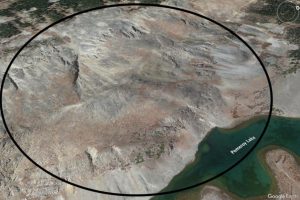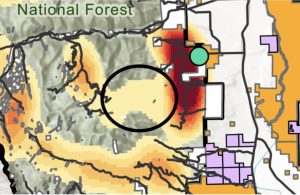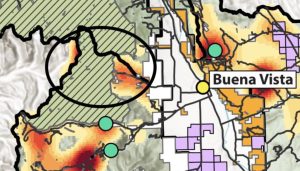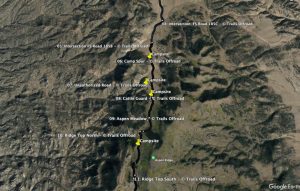
RE: Salida Leadville NOPA Camping
Dear Planning Team Members:
Please accept this correspondence as comments on the Notice of Proposed Action (NOPA) Salida/Leadville Forest Service Districts Vehicle Based Dispersed Camping Management Plan. The Organizations have been involved in stewardship, volunteerism, education, and motorized advocacy within both districts for many years.
Who We Are
Before addressing our specific comments, we believe a summary of each Organization is needed. The Colorado Off-Highway Vehicle Coalition (COHVCO) is a grassroots advocacy organization of approximately 2,500 members seeking to represent, assist, educate, and empower all OHV recreationists to protect and promote off-highway motorized recreation throughout Colorado. COHVCO is an environmental organization that advocates and promotes the responsible use and conservation of our public lands and natural resources to preserve their aesthetic and recreational qualities for future generations. The Trails Preservation Alliance (TPA) is an advocacy organization created to be a viable partner to public lands managers, working with the United States Forest Service (USFS) and the Bureau of Land Management (BLM) to preserve the sport of motorized trail riding and multiple-use recreation. The TPA advocates for the sport and takes the necessary action to ensure that the USFS and BLM allocate a fair and equitable percentage of public lands access to diverse multiple-use trail recreational opportunities. CORE is a motorized action group dedicated to keeping motorized trails open in Central Colorado and the region. CORE has 12 adopted trails spread throughout the Salida and Leadville Districts and has accumulated several thousand volunteer hours in both Districts over the past few years.
Discussion
1. General Comments
The Organizations appreciate the adaptive management strategy evaluation noted in the Purpose and Need of this proposal that includes ‘recreational value’ as a stated condition. Our organizations support many of the measures listed within this proposal to help manage the negative impacts of specific camping. We also recognize that VB Camping is happening in particular areas for specific reasons. Those include users choosing campsites for locations, camping as recreation, and accessing multi-recreational opportunities.
2. Citizen Science
The Organization must note the citizen-based research and engagement in conjunction with crowdsourcing data efforts. These efforts have been part of varying projects, which have yielded a wide range of results. Some results have been excellent. More commonly, this flexibility has resulted in conclusions or recommendations not following basic scientific processes and conclusions lacking value. Often these efforts represent a significant researcher bias in the research process. This lack of awareness may considerably impact recreational planning efforts from low-quality data and research.
Data collection in an area where observer bias is an issue is typical when observers want to feel important; others want to lead research to a single conclusion without losing scientific credibility. Often personal bias or ideological opposition, or conflict is sought to be veiled as scientific research.
To combat these negative issues, Crowdsourcing and Citizen Science Act of 2016 §402 of Public Law 114-329 mandates that agencies must verify the credibility of crowdsourcing data or citizen science efforts if agencies use Crowdsourcing and Citizen Science information. Crowdsourced data includes any information solicited from groups or organizations. Citizen Science includes creating resource questions; creating project design; conducting experiments; data collection interpretation and analysis; developing technology, and problem-solving. This requirement is not satisfied by the mere presence of a group collecting data for the agency or their usage.
The Organizations bring up Citizen Science because early on during the Envision Chaffee Rec Plan creation, Colorado Mountain Club (CMC) introduced the Recreation Impact Monitoring System (RIMS) app to track and locate campsites within Chaffee County. This app and its use were pushed frequently during the initial Envision Chaffee County meetings. The Organizations are concerned with the Vehicle-Based Camping Heat Map because its data is highly inaccurate for the Salida District within Chaffee County. Envision and CMC held training and enlisted many volunteers to collect campsite data for areas within Chaffee County.
The Heat Map in this proposal is fascinating because the map corresponding to Chaffee County is highly inaccurate. At the same time, the Leadville District map for areas outside of Chaffee County is much more accurate in depicting VB camping. The Organizations can assume this is the case because the RIMS app was rolled out exclusively in Chaffee County as part of Envision Chaffee County. Another question concerning the Heat Map is what constitutes dark red, red, orange, or yellow? How many sites were recorded in each area to create each color?
We have several recommendations and examples below showing the inaccuracies of the Heat Map.

Figure 1.
In the above photo taken from the Project’s VB Campsite Heat Map (Figure 1.), the circle on the top left shows a campsite cluster along some routes shown south of Cottonwood Pass (CR 306) near the summit on the Chaffee County Side. The problem with this data is that the routes shown connecting to Cottonwood Pass are Admin Routes and are not open to the public, and they do not contain VB Campsites. Going further south from those routes with the red, orange, and yellow shading colors that extend south to NFSR 349, which departs the south Cottonwood drainage, and NFSR 344 shows other errors. First, having VB Campsites in this area is impossible because no roads exist. And Second, CORE is the trail adopter for NFSR 349, and there are no campsites now, or in the past, near the end of NFSR 349, and there are no campsites along the Ptarmigan Lake hiking trail that goes north over the ridge and to the lake (shown in the orange shade).
Further, CORE has documented six campsites along NFSR 349, which is 2.5 miles long. Six dispersed sites within 2.5 miles are not high-density. Those on-ground facts make this map section inaccurate, and there should be no VB Camping shading in this area.
The circle to the bottom right (Figure 1.) above (dark red area) is around NFSR 344, and there is a high concentration of campsites along the road. However, this project is referencing VB campsites, and the sites along NFSR 344 are near the road, and the ones not right next to the road are no more than 500′ away from the main route to the south and 200′ away from the main route to the north. However, the dark red area extends what appears to be more than 1 mile on either side of NFSR 344, which is not possible due to the terrain.
The dark red (Figure 1.) also encompasses the entire first section of NFSR 348 to the south. NFSR 348 does have 7 VB campsites located close together at the direct intersection of NFSR 348 and NFSR 344. But there are very few sites along NFSR 348 after the junction, and CORE volunteers have documented no more than 6-9 suitable campsite areas along the next 5 miles of the route. These areas are only suitable for a tent next to a vehicle or for the vehicle to house campers directly. You cannot pull a trailer of any kind up NFSR 348. This graphic depiction of the dark red area would make an unknowing reader assume the entire red circular area contains sites and the shaded colors outward also include sites, which is not the case.

Figure 2.
Two other examples of mapping issues in Chaffee County showing VB campsite data are in the Chalk Creek Drainage (Figure 2.), near Tincup Pass and Pomeroy Lakes. First, the top left circle shows the upper part of Tincup pass, and the color shades go over the ridge to the north and into the South Cottonwood drainage. There is extremely limited VB camping on the north side of Tincup Pass (NFSR 267), VB camping on the north side is mainly in the first 4 miles of the pass, and each site is close to the road. At the 4-mile point, the Colorado trail crosses the road, and from that point, for the next 2.17 miles, there is only one camping area (at the top of sawmill hill) before the end of the project area (pass summit). Again, this would make this proposal’s shading area highly confusing and inaccurate. The shading should be along the road and not extend north and south of the route.
The circle to the bottom right (Figure 2.) encompassing the orange area has zero campsites. It could not include any VB campsites because there is no road to the area, and the orange color is on top of a steep ridge (see below Figure 3.).

Figure 3.
The Google Earth screenshot (Figure 3.) shows this area, looking west from Lower Pomeroy Lake. This vantage point (black circle) shows the orange location on the VB Camping Map; there are no campsites, no roads, and extremely limited (dangerous) cross-county hiking access above the treeline. This shaded area can’t contain VB Campsites.

Figure 4.
The section shown by the circle above (Figure 4.) seems connected to the Raspberry Gulch VB Camping area and the end of the roads in the Mount Antero Trail System and Mount While. But there are no connecting roads between the two regions, and no VB campsites exist in the circled area. The shaded area covers the Browns Creek and Little Browns Drainage, and there may be dispersed campsites along the singletrack trails in each drainage. Still, those inventoried (if there is campsite inventory) should be removed from this project and proposal.

Figure 5.
Perhaps the most notable use of citizen science applied incorrectly in this proposal is pictured above (Figure 5.). The black circle depicts an area that includes the Collegiate Peaks Wilderness
Area hiking trails, which lead to Browns Pass, Kroenke Lake, Mt. Harvard, and Mt. Columbia. VB Camping is only available along NFSR 365, NFSR 365.A, NFSR 365.B, and NFSR 365.C. The VB Camping Heat Map clearly shows camping activity along the NFS Roads. Still, it continues up the drainage, and you can see the shading extending past the Wilderness Area Overlay. This shading is undoubtedly not from VB Camping and is data carried over from the CMC RIMS App data (same as Figures 1., 2., 3., and 4.) that volunteers gathered through the Envision process. These volunteers collected all dispersed camping activities, and that exercise was not specific to VB Camping. There is certainly a lot of recreational activity in this area. Users frequently camp in existing sites along the roads, in the Trailhead Parking Area, and in most cases, along the hiking trails after exiting their vehicles and hiking. If hikers are camping along the singletrack hiking trails, they are doing so to summit peaks, Wilderness Area access, fish at Alpine Lakes, or base camping for multi-day excursions. This form of camping is NOT VB Camping and should not be included in this proposal.
These facts highlight why this proposal should not include the campsite data collected through the RIMS app or data collected through citizen science stemming from Envision.
How can The Agency accurately account for only VB Campsites and not include sites that are not VB?
How can The Agency include data from sites that clearly don’t exist, such as those in Figures 1 and 2.?
How can The Agency separate biased campsite data, which could have been collected by volunteers expressly looking to limit Camping in Chaffee County?
These are also examples of why a heat map is not a good representation of VB campsites or for the public to view this information. An unknowing citizen looking at this map could comment on incorrect information. They might not only see colors where VB campsites do not exist, but they might assume continuous campsites throughout the dark red, red, and orange, which is inaccurate. This type of map and the citizen science that created it should not be used for this project because of these issues. Because of these facts, some high-density corridors for designated dispersed campsites should be modified (see additional comments). The Background section of the proposal clearly states:
“Over the past several field seasons, the districts have gathered VBDC data to determine current resource conditions and concerns in areas popular for VBDC.”
District information can’t be the only data used to create this map in Chaffe County, or the errors and questions noted above would not be present. The Organizations recommend excluding any data collected through citizen science methods, leading to these inaccuracies, false locations, and heat signatures that do not exist for VB Camping.
Without excluding the incorrect data, it’s tough to know if the proposed action meets the need or how well it protects the environment and addresses issues and concerns. Inaccurate campsite data will also make evaluating the Conformance with Management Direction section and the Forest Plan Goals challenging. This proposal also references campsites that could interfere or conflict with Wilderness and Colorado Roadless Areas. Still, with the noted inaccuracies in these comment sections, it’s unknown if a genuine issue exists and, as shown in Figures 1. and 2. if some campsites even exist.
3. High-Density Corridors
The Organizations continue to recommend only high-density corridors be considered for designated campsites. These roads usually accommodate most vehicles, including 2WD and large RV rigs. The areas we feel appropriate to consider as high-density corridors are:
Halfmoon Access Road CR 11 – We support the designated dispersed VB Camping up to the Mt. Massive Summit Trail. After that point, NFSR 110 should remain open for dispersed Camping.
Clear Creek Drainage CR/NFSR 390 – We support designated dispersed VB Camping for NFSR 390 and NFSR 390.A.
South Cottonwood Drainage/Mineral Basin NFSR 344 – We support designated dispersed VB camping for NFSR 344 and NFSR 344.G. Several areas above the Green Timber Gulch Trailhead, along NFSR 344, were closed to camping and motorized access in the early 2000s due to Boreal Toad concerns. The public has respected those closures and they are still intact today. NFSR 344.G is a short spur and is mostly used for dispersed camping, we support designating these sites. As shown in section 2, the data surrounding NFSR 349 and 348 is inaccurate, and these routes should not be included for designated dispersed VB camping. NFSR 349 and 348 should remain open to dispersed camping as there are no issues and therefore do not require escalating management in the form of restriction.
North Cottonwood NFSR 365 – We support designated dispersed VB camping for this road segment.
Aspen Ridge NFRS 185, 187 – We only support designated dispersed VB camping along these two routes.
Fourmile North NFRS 375/NFRS 376 – these two roads are the most highly traveled corridors within the Fourmile North Area. We support designated dispersed on these two routes only.
CR 306 – We support designated dispersed along the highway. We support a new campground facility being built. The Admin Routes near the top of the pass should be removed.
Fourbay – We support designated dispersed VB camping on the routes around the Forebay recreational access, both on the north and south side of the reservoir.
Marshal Pass NFSR 203 – We only support designated dispersed VB camping along the 203 route.
Raspberry Gulch/Browns Creek NFSR 272 – We support designated dispersed VB camping on all the routes within this area.
We support the creation of the proposed campgrounds in Fourmile, Raspberry Gulch/Browns Creek, South Cottonwood, Middle Cottonwood, the Granite Area, South Twin Lakes, Fourbay, Halfmoon, and Turquoise Lake.
We recommend including a campground in North Cottonwood Drainage at the end of NFSR 365.
4. Travel Management
We encourage the project team to include the routes adjacent to Browns Canyon National Monument that currently exists to allow VB Camping. See Figure 6. below, showing Aspen Ridge, the campsite pins, and other notable features. The routes leading to these sites are between the NFSR 185.B intersection and the top of Aspen Ridge and are on the west side of the road.

Figure 6. Aspen Ridge NFSR 185
We encourage the project team to include routes near the Twin Lakes Dam, Figure 7. below. Three distinct loops have formed near the Twin Lakes Dam recreation area. These allow fishing/water access; one loop is for the Interlaken Hiking Trailhead. We recommend The Agency consider designating these as routes for the public to use; this area might be suitable for daily use without a camping option.

Figure 7. Twin Lakes Dam
Some roads near Fourbay should also be kept. Connecting many of the NFSR 125s and user- created routes into looping options with designated dispersed makes the most sense here, allowing users to cycle through and back out if no campsites are open.
5. Management Triggers
Under Public Health and Safety – Camping-related trash and/or human waste left at a specific area or site more than 2xs per season. The Organizations are concerned with this Management Trigger because frequently, our volunteer groups pick up trash in the same areas multiple times per season. Garbage left at a campsite 2xs per season is commonplace, and regions like Fourmile would have no sites left if this type of management trigger resulted in closure. Because of this, the trigger language might need further clarification. Also, who documents a management trigger? Can only Agency staff make these documentations, or will volunteers and property owners be allowed to register these triggers? We recommend that only Agency Staff record management triggers to avoid errors officially.
Under Fire Management – an increasing trend in human-caused, camping-related incidents in one geographic area in a two-year period. The Organizations frequently volunteer on the motorized routes, which allow VB Camping in the proposal area. Occasionally our volunteers come across a concern dealing with campfires, but the most common issue we have observed is campers building fires during a fire ban. Sometimes this act is defiant behavior when the camper knows there is a fire ban, but most times, this behavior stems from ignorance. This proposal should coincide with notice, education, and enforcement during fire bans. Scientific conditions
dictate when a fire ban is implemented, and those conditions necessitate that public awareness should be of utmost importance. Improperly maintained campfires pose a danger, but any fire during the conditions necessitating a fire ban poses the most threat. Increasing notifications and modifying systems in place will help campers know current regulations. We would encourage the installation of signage and a notification system specific to Fire Regulations separate and displayed prominently compared to other forest information. We would also recommend these be in place at the beginning of all the high-use corridors and updated with changing conditions.
Under the Resource Section – camping opportunity exceeds current inventory of sites. This row in the proposal is confusing based on the wording, and The Organizations recommend updating the language to be more straightforward. This section describes the event when campsite desire exceeds the current campsite supply. In that event, the trigger seems to suggest that new sites should be designated where resource impacts are absent or can be mitigated. If correct, we support finding new locations to create more dispersed campsites to accommodate demand. Adding infrastructure to existing camping areas may not solve a supply issue. Adding restrooms, campfire rings, containment fencing is a better fit as a management trigger under Public Health & Safety and/or Lands & Uses.
6. Seasonal Closures
Under the WIL 6 category for Wildlife, it is noted that designated sites within mapped elk production range, winter range, or in essential migration corridors will be closed during critical times. The Organizations would like to point out that if VB campsites are located along roads that are already seasonally closed due to the noted wildlife concerns, those sites are, by default, already closed to VB camping because they can’t be accessed during the existing closures.
III. Conclusion
The Organizations support designated dispersed areas discussed previously in our comments, and we support the construction of the proposed campgrounds. We recommend the Forest Service removes the incorrect data from the maps to avoid public confusion. We recommend the Forest Service clarify the management trigger language in the noted areas. We recommend including some routes to facilitate dispersed camping or recreation.
Thank you for your consideration.
Marcus Trusty
CORE President
Chad Hixon
TPA Executive Director
Scott Jones
COHVCO Authorized Signer
